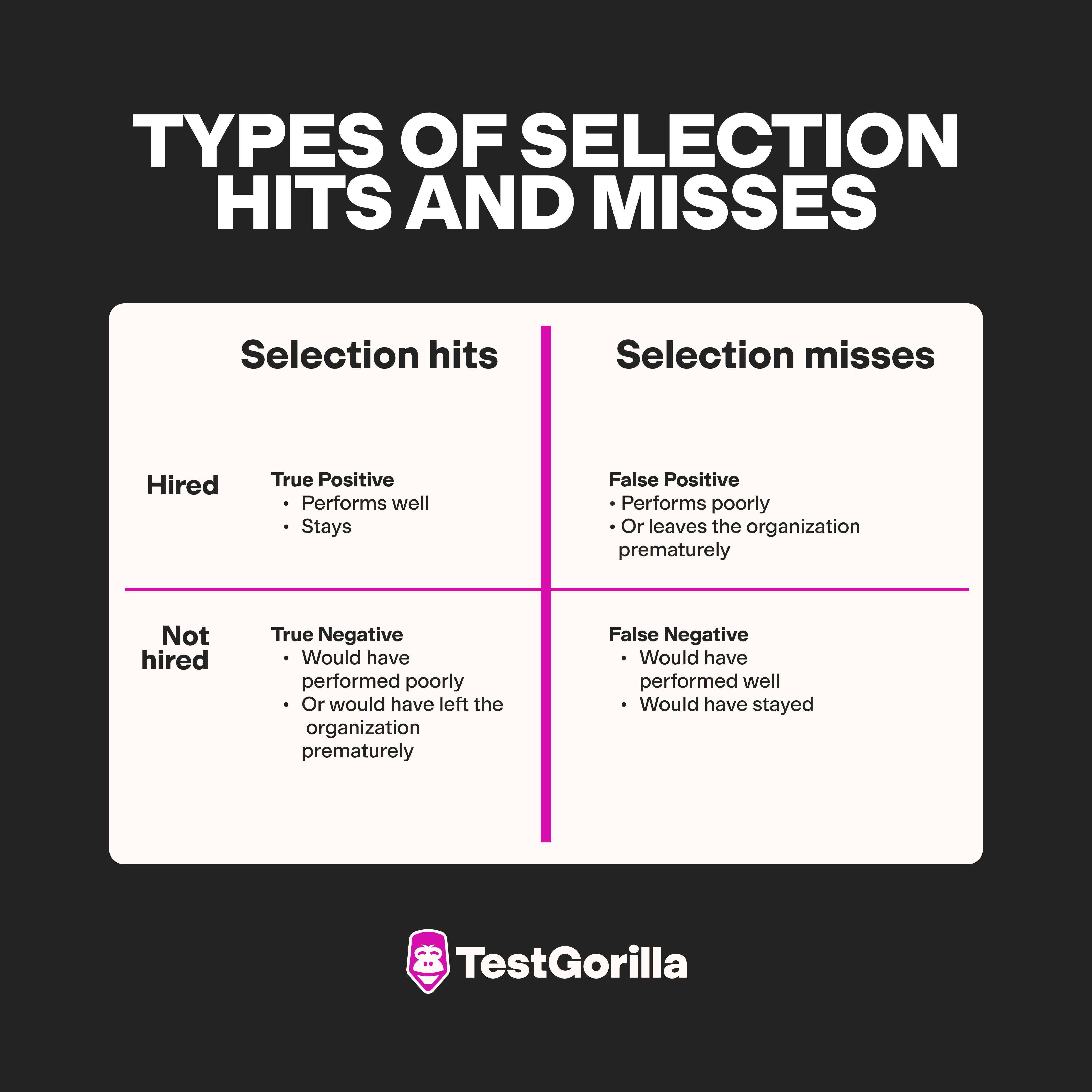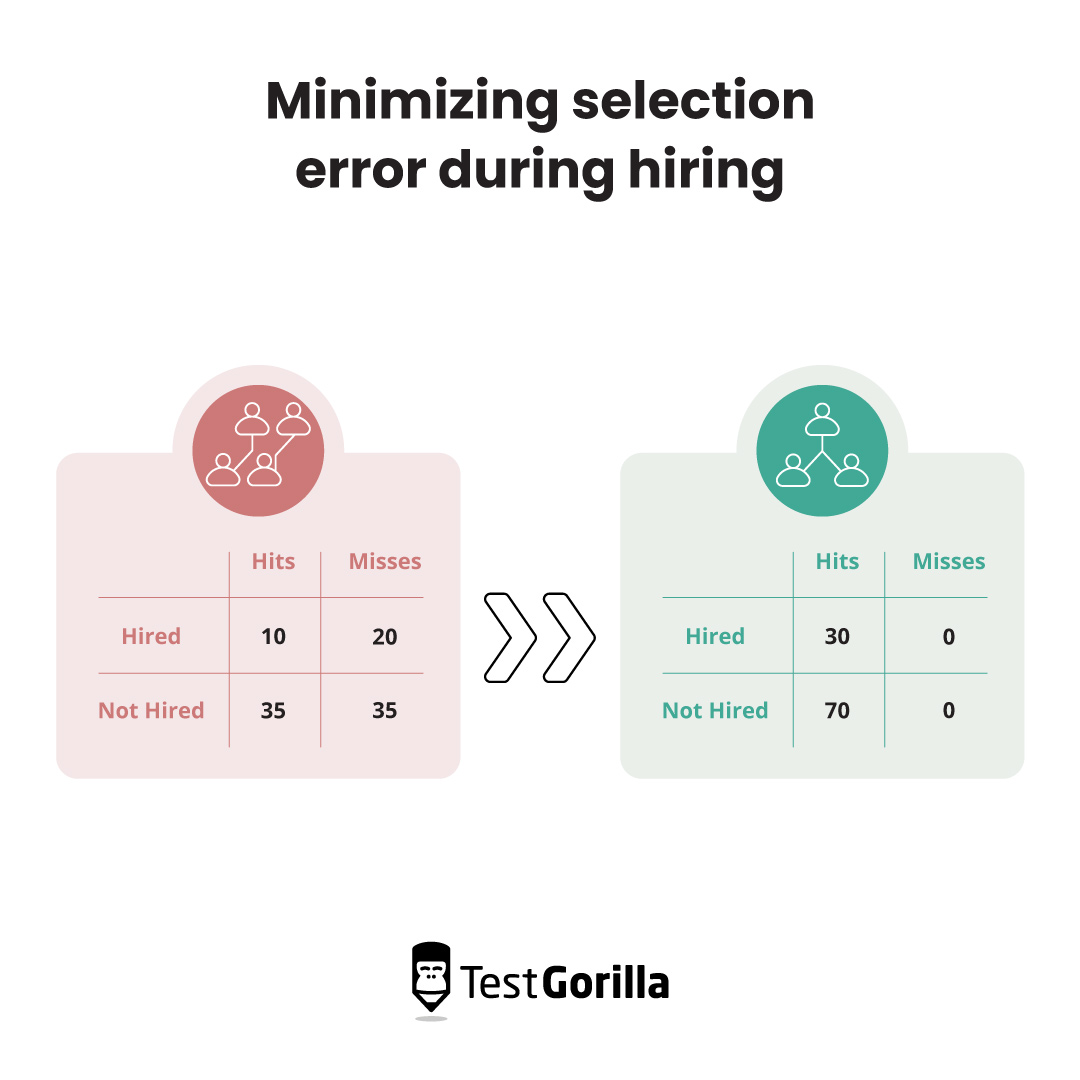What is selection error and how do you minimize it during hiring?
Science series materials are brought to you by TestGorilla’s team of assessment experts: A group of IO psychology, data science, psychometricians, and IP development specialists with a deep understanding of the science behind skills-based hiring.
When making selection decisions about applicants, organizations aim to maximize selection hits (a correct hiring decision) and minimize selection misses (an incorrect hiring decision). Hiring a candidate who will perform well, or declining to hire a candidate who will not, is considered a hit; hiring a candidate who will perform poorly, or declining to hire a candidate who would have performed well, is considered a miss.
To maximize hits and minimize misses, organizations must reduce selection error. In this science series article we’ll walk you through the science behind selection error, as well as some watertight strategies for minimizing selection error during hiring. Let’s dive in.
What is selection error?
Selection error, in the context of employment screening and hiring, refers to mistakes made during the selection process that lead to the hiring of unsuitable candidates or the rejection of suitable candidates (i.e. selection misses).
As we mentioned above, selection error must be reduced if employers want to maximize hits and minimize misses during hiring. In other words: minimized selection error = better hiring decisions.
Minimizing selection error is crucial for building a strong and effective workforce. If it’s left unaddressed, selection error can wreak havoc for an organization, affecting its overall performance, productivity, and employee satisfaction.
There are two main types of selection errors
Before we take you through some of the steps you can take to minimize them, let’s dive a little deeper into the kinds of selection error that can occur during the hiring process.
There are two main types of selection error:
False Positives (Type I Error): These occur when a candidate is wrongly identified as a good fit for the job when they are not. Essentially, a false positive is when a candidate is hired (a seemingly positive outcome), but they end up performing poorly in the role or do not meet the job requirements (ultimately a negative outcome for the employer). Alternatively, they may leave the organization voluntarily shortly after being hired. This is the quintessential “mis-hire”, and something that all employers want to avoid.
False Negatives (Type II Error): These occur when a candidate who would have been successful in the job is mistakenly rejected during the screening or selection process. In other words, a false negative occurs when a good candidate is not hired, and an employer misses out on their potential contributions to the organization. Though no mis-hire has taken place, the employer has missed out on a great candidate for the role.
Below, you can see a table showing the two different types of selection hits and selection misses. The column on the right outlines our two types of selection error; the False Positives and False Negatives discussed above.
As you can see, selection errors are broader than just mis-hires. They also account for the opportunity costs incurred when an employer rejects a well-suited candidate – an invisible cost that’s far harder to account for than a mis-hire.
An example of how selection error might play out
To help you really grasp what selection error is all about, here’s an example of how it might play out in a real-life hiring scenario.
Imagine that a company is hiring for a software developer position, and they use just one technical assessment to screen candidates. The assessment can either label a candidate as a "Pass" (suitable for the role) or a "Fail" (not suitable for the role).
In this context, a selection hit can occur in two ways:
A true positive hit: a candidate who is truly qualified for the software developer position and a good fit for the company takes the assessment and is correctly labeled as "Pass." The candidate is hired and performs well in the role.
A true negative hit: a candidate who is unqualified for the software developer position or who lacks fit with the organization is not hired.
A selection miss can also occur in two ways in this scenario:
A false negative miss: a highly skilled candidate takes the assessment but is incorrectly labeled as "Fail." The candidate is not hired, despite being well-qualified for the software developer position and a good fit for the company.
A false positive miss: a candidate with inadequate skills and qualifications for the software developer position is incorrectly labeled as "Pass." The candidate is hired but struggles to perform well in the role. Alternatively, the candidate may be well qualified for the position but holds different work values and preferences that are misaligned with the company. That candidate may receive the position but voluntarily leave the company shortly afterward.
In both of these instances of a miss, whether an opportunity is missed or a mis-hire occurs, the employer loses the time and money spent on the hiring process.
As you can imagine, when selection misses build up, the costs incurred by an employer can become significant (the diagram below demonstrates how minimized selection error reduces the number of misses and increases the number of hits). So, how can you minimize selection error for a successful hiring process?
7 strategies for minimizing selection error during hiring
In the simplified example above, we explained selection error in the context of a technical screening test. However, in order to begin minimizing selection error, it’s important to understand that it can occur at any stage of the hiring process. Selection error can result from various factors, often in combination.
This being said, organizations can increase hits and reduce misses during hiring by using evidence-based strategies that minimize selection error. We’ve outlined 7 strategies for you below.
1. Conduct a comprehensive job analysis
Conduct a thorough job analysis to identify the key skills, knowledge, and attributes required for the position. This will help you create accurate job descriptions and relevant assessment criteria, ensuring you select candidates who match the most up-to-date job requirements (and are likely to be hits).
2. Use multiple assessment methods
Use a combination of interviews, technical assessments, behavioral assessments, and reference checks to gather a holistic view of the candidate's suitability for the role. A holistic approach to hiring helps employers hire candidates who are well-qualified and have work preferences and values that align with the organization. This, in turn, boosts the likelihood of selection hits.
3. Use standardized assessments
Ensure that the assessment process is standardized, meaning every candidate is evaluated using the same criteria and benchmarks. A lack of standardization leads to unfair hiring practices. This leaves your evaluation process wide open to the influence of unconscious biases, and therefore more vulnerable to selection misses.
4. Use culture add assessments
Use a culture add test to ensure the candidate’s work preferences and values align with the organizations to prevent selection errors. Candidates who are well-qualified and a good fit for a company’s culture are more likely to stay with the organization.
5. Carry out interviewer training
Train hiring managers and interviewers to conduct fair and structured interviews, reducing the influence of biases during the interview process. When biases enter selection decisions, selection misses are more likely to occur.
6. Implement trial periods or probation
Consider implementing trial periods or probation periods for new hires. This will help you to assess the candidate's actual performance on the job before making a final decision, increasing the likelihood of selection hits.
7. Regularly evaluate your selection process
Continuously evaluate and gather feedback on the effectiveness of your selection process and gather feedback from employees to identify areas of improvement. This way, if a certain part of your process is maximizing selection error, you can quickly identify and amend it.
The best insights on HR and recruitment, delivered to your inbox.
Biweekly updates. No spam. Unsubscribe any time.
Minimize selection error with TestGorilla
By implementing these strategies, your organization can reduce the chances of making costly selection errors and build a stronger, more productive workforce. And what’s more, TestGorilla can help you implement them.
Our pre-employment screening tests facilitate a standardized, multi-measure, and holistic hiring process. Developed by experts and trusted by over 10,000 employers globally, TestGorilla’s test library is a tried and trusted tool for minimizing selection error and unconscious bias during hiring. These science series blogs are here to help you understand the science behind TestGorilla tests and use them correctly.
If you want to learn more, keep your eyes peeled for a follow-up article, where we’ll dive deeper into the role of valid, reliable selection tools in minimizing selection error. In the meantime, you can check out additional content from our science series here:
Related posts
You've scrolled this far
Why not try TestGorilla for free, and see what happens when you put skills first.

















